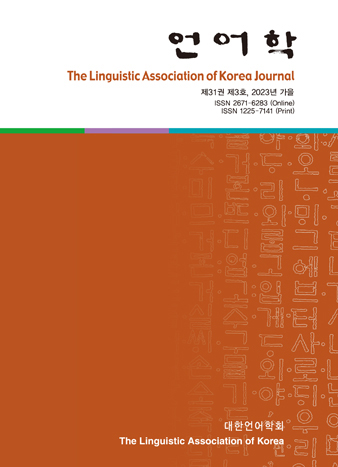대한언어학회 전자저널

-
온라인 수업에서 상호작용 교수설계가 학습몰입과 학습지속의향에 미치는 영향: N대학 교양영어 수업의 사례를 중심으로
-
The Internal Structure of Reflexives and a NP-internal Movement Analysis
-
Chinese Undergraduate Students’ Motivation to Learn L2 English and L3 Korean Simultaneously
-
What Restricts or Boosts the Use of Internally-Headed Relative Clauses in Korean?
-
English Wh-Question Formation by Korean Elementary and Middle School EFL Students
-
Korean ESL Learners’ Individual Differences in Intercultural Sensitivity and Language Development
31권 3호 (2023년 9월)
- 한·중 미각어의 신체화 양상 대조 연구: ‘맵다’류 어휘를 중심으로
-
관영욱
Pages : 1-24
Abstract
Keywords
# 미각어(taste-terms) # 맵다(spicy) # 신체화(embodiment) # 개념적 혼성 (conceptual blending) # 의미 확장(meaning extension) # 한중 대조(Korean- Chinese contrastive study)
References
- 권희정. (2008). 韓中基本味覺語 의미확장 공통성 연구. 南道文化硏究, 15, 7-38.
- 김동환. (2013). 인지언어학과 개념적 혼성 이론. 박이정.
- 김동훈. (2023). 개념적 혼성 기반 보조용언 ‘-고 말다’의 의미 구성 연구. 어문연구, 116, 5-30.
- 김순자. (2015). 한·중 매운맛 형용사의 의미 확장 대조 연구. 언어와 정보 사회, 26, 101-133.
- 김중현. (2001). 국어 공감각 표현의 인지 언어학적 연구. 담화와 인지, 8(2), 23-46.
- 김해미. (2014). ‘맵다’ 계열 어휘의 확장 의미 연구. 국어국문학, 169, 5-48.
- 문금현. (2015). 미각어 관련 고정표현에 나타난 다의화와 인지의미 양상. 새국어교육, 102, 391-427.
- 석수영. (2014). 한ㆍ중 감정 표현의 개념화 양상: 미각어를 중심으로. 언어과학연구 68, 191-214.
- 석수영. (2020). 한·중 감각어의 신체화 연구. 역락.
- 양기. (2014). 한·중 미각 형용사 대조 연구: 시다, 달다, 쓰다, 맵다, 짜다를 중심으로. 전남대학교 석사학위논문.
- 윤영은. (2013). 언어의 의미 및 화용 이론과 실제: 형식 의미론적 관점과 인지 의미론적 관점을 중심으로. 한국문화사.
- 이경수. (2012). 한국어 미각형용사의 의미와 개념화. 상명대학교 박사학위논문.
- 이범열. (2016). 현대중국어의 미각어를 통한 감정 표현. 中國語文學誌, 57, 425-452.
- 이선희. (2019). 한중 미각어 ‘쓰다’, ‘苦’계열 어휘의 의미 확장 및 개념화 양상 대조연구. 中國學, 68, 101-122.
- 이선희·김미금. (2019). 한중 미각어 ‘달다’, ‘甜’계열 어휘의 의미 확장 및 의미구성양상 대조 연구. 中國學論叢, 64, 75-98.
- 이승명. (1988). 국어 미각 표시 어군의 구조에 대한 연구. 국어국문학, 100, 335-358.
- 임지룡, 요시모토 하지메, 이은미, 오카 도모유키 옮김. (2004). 인지언어학 키워드 사전, 한국문화사.
- 임지룡. (2005) ‘사랑’의 개념화 양상. 어문학, 87, 201-233.
- 임지룡. (2006). 말하는 몸: 감정 표현의 인지언어학적 탐색. 한국문화사.
- 임지룡. (2007). 신체화에 기초한 의미 확장의 특성 연구. 언어과학연구, 40, 1-31.
- 임지룡. (2008). 의미의 인지언어학적 탐색. 한국문화사.
- 임지룡. (2017) 감각어의 의미 확장 양상과 특성. 국어교육연구, 63, 335-372.
- 최현석. (2013). 인간의 모든 감각. 서해문집.
- 황혜진. (2002). 미각 형용사에 관한 의미론적 연구. 서울여자대학교 석사학위논문.
- Fauconnier, G., & Turner, M. (1994). Conceptual Projection and Milldle Spaces.
- Cognitive Science Technical Report 9401, San Diego.
- Fauconnier, G. (1997). Mappings in thought and language. Cambridge: Cambridge University Press.
- Lakoff, G., & Johnson, M. (1980). Metaphors we live by. Chicago: University of Chicago Press.
- Rohrer, T. (2007). The body in space: Dimensions of embodiment. Body, Language And Mind, 1, 339-377.
- Ungerer, F., & Schmid, H. J. (1996). An Introduction to Cognitive Linguistics. London and New York: Longman. (임지룡ㆍ김동환 옮김(1998). 인지언어학 개론, 태학사).
- 黄伯荣·廖序东. (1991). 现代汉语. 高等教育出版社.
- 中国社会科学院语言研究所词典编辑室编. (2012). 现代汉语词典(第6版), 商务印书馆.
- 吕贞男. (2012). 汉韩味觉词的语义与隐喻化特征―酸/甜/苦/辣/为主. 중어중문학, 51, 385-412.